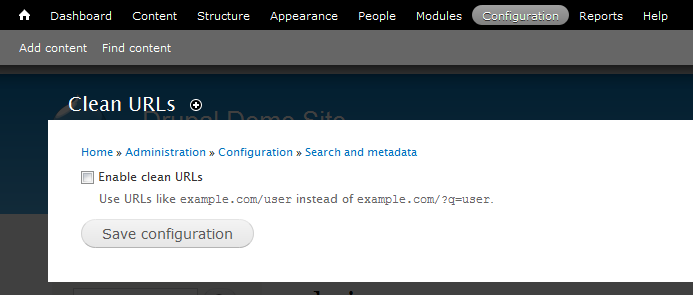Enabling Clean URLs in Drupal 7
Drupal 7 has the option to allow friendly URLs which makes for more memorable and easier to remember web page addresses for users of the CMS. Drupal also refers to these URLs as clean URLs. The following tutorial explains how to go into the interface to enable clean URLS and also explain the difference with the option diabled.
Setting up Search Engine Friendly URLs in Drupal 7
- Log into the Drupal dashboard as an administrator.
- In the Menu bar at the top of the screen, click on Configuration. Look for Search and Meta Data and then under that menu look for Clean URLs. Click on it in order open the screen as shown below:

- Click on the checkbox in order to Enable Clean URLs. Note that by default this option is disabled.
- Click on the Save configuration button in order to save your entry.
To understand the difference between a search engine friendly (SEF) URL and a URL that is not friendly, take a look at the table below. Note that Drupal is referring to the SEF URL as a a "Clean URL".
| Clean URLs Disabled | Clean URLs Enabled |
|---|---|
| http://domain.com/article5475&698 | http://domain.com/article-explains-URLs |
Keep in mind that since Drupal is generating these URLs based on the database within the Drupal installation. If the website is moved, then the URLs will need to be rebuilt by Drupal. This is done by disabling the Drupal option for the clean URLs, saving the change, then re-enabling the option so that Drupal installation re-creates the URLs based on the new location.
Comments
|
27 Points
|
2013-04-02 3:57 pm
This does not seem to work.
I just installed Drupal through Softabulous and followed these directions, but there is no checkbox at the place in Drupal you show above. Then, when I click on "Run the Clean URL Test" it says, "The clean URL test failed." So . . . how do we get clean URLs? George |
|
Staff 12,339 Points
|
2013-04-02 4:35 pm
Hello George,
Thank you for your comment. As a test we performed a new installation of Drupal, and enabled this feature successfully. If you have modified your Drupal with Modules and/or Themes it may have changed the functionality as well. You can try reverting back, or reinstalling Drupal and testing again. Also, here is a link to the official Drupal support page that offers other solutions. If you have any further questions, feel free to post them below. Thank you, -John-Paul |
|
27 Points
|
2013-04-04 3:00 pm
Hi thanks for trying to help, but I cannot make much sense of the Drupal help pages. It is incredibly complicated and not organised well.
It took my a long time to figure this out. This is the final solution. I opened the .htaccess file and after a lot of experimenting found that these lines in bold are the problem. (I have drupal installed in a subdirectory.) You have to delete the # in front of RewriteBase and write the name of your subdirectory after the / . (Yes, you would think any competent programmer would include that in the install, but that is beside the point, I guess.) # Modify the RewriteBase if you are using Drupal in a subdirectory or in a # VirtualDocumentRoot and the rewrite rules are not working properly. # For example if your site is at http://example.com/drupal uncomment and # modify the following line: <strong> RewriteBase /outdoors</strong> # # If your site is running in a VirtualDocumentRoot at http://example.com/, # uncomment the following line: # RewriteBase / Finally, anyone who does not want to spend a lot of time tinkering around with a complicated system should[i]<strong> NOT</strong>[/i] use Drupal. It is not very easy to learn. At all. |

We value your feedback!
There is a step or detail missing from the instructions.
The information is incorrect or out-of-date.
It does not resolve the question/problem I have.
new! - Enter your name and email address above and we will post your feedback in the comments on this page!